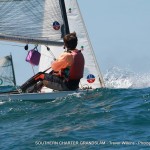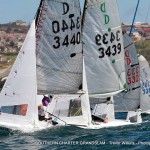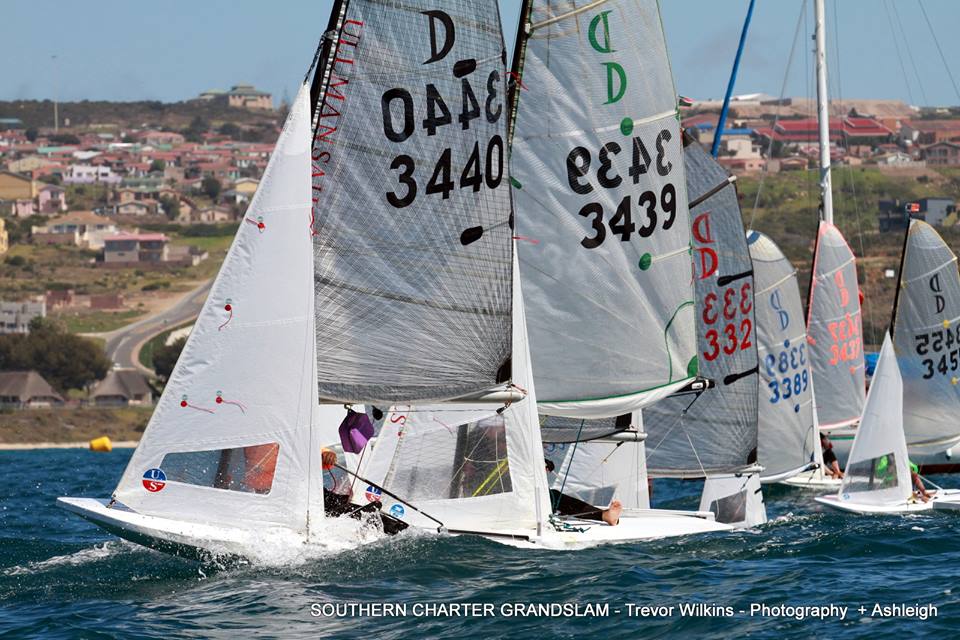Techniques of Successful Starts
It sounds so obvious, but the first rule of making the crucially important ‘good start’ is to get out to the start area early – preferably first. This will give you time to track the mean wind and look for any tidal Influences.
If it’s a line start, a compass is the easiest, quickest and most accurate way to check line bias. Put the boat head to wind and take a reading, checking this several times to establish a mean direction. Then sail down the line on starboard to take a bearing of the line. Add 90 degrees to this reading. If the result is greater than the wind bearing there is a port end bias. If it is less, the starboard end is favoured.
If the starting area is close to the shore or you are sailing inland – it really pays to get a good transit, in case you lose sight of either end of the line, and long lines always have sag in the centre which you may be able to take advantage of.
By the time the 5 minute signal is given, you should have made up your mind completely about which end to be and start as close to it as possible. The only time I’m a little wary of these tactics are when there is a five minute disqualification rule In force and the competition is very high. In these circumstances we tend to choose a slot a little further away from the pin so that – if we are slightly early – we are more likely to be hidden.
When there is a one-minute, round the ends rule and you are over – you can still get away with a reasonable start by gybing and tacking round the pin.
Get the crew to provide the countdown to give the helm full powers of concentration on positioning the boat. And always make sure before the start that the sails and rig are set and tuned for the conditions prevailing.Boat control and pre start manoeuvres are vital, and it takes a great deal of practice and experience to always pull off a good start.
The ideal situation to try and create is one in which – with 10 seconds to go – you have created a boat’s length of space to leeward of you by sailing slowly towards the line as close to the wind as possible. With 3 seconds to go you should have powered off into the leeward space to hit the line at full speed on the gun with your nose clear ahead of the boats above and below you.
Gate starts are, of course, very different – although the rules about getting out to the area early still apply. It is usually fairly obvious whether starting early or late will pay off but it is sensible to be more reluctant to ‘go for it’ on gates and better to play the fleet and come out of the gate in good shape somewhere near the middle. It is again important to work hard to create the gap to leeward by sailing close hauled and clip the back of the gate boat as close as possible sailing at full speed. Finally, always read the sailing instructions very carefully – with particular regard to the time when the pathfinder is released Even if it is obviously right to start late – don’t be greedy! A conservative approach is the most reliable; you won’t win championships by taking risks.
Rounding The Leeward Mark
The second reach is usually broader than the first, and so you have to be careful not to loose concentration as the boat inevitably slows. All the first burst of adrenalin is now burnt up and you have to settle into the race and begin to think ahead about positioning.
Wherever you are, and especially on this leg, you must not sail in dirty air so decide your best positioning for the leeward mark approach, and work out into clean air. With tide on the course it may pay to sail deep rather than to put in extra gybes later Competitors behind will always sail higher so do not be tempted up unless there s c good reason to go higher.
Re-check your sails, and settings. The centerboard should be nearly up for a broad reach – less drag – and your sails should be as powerful as possible. Watch the water because it is easy to forget to shift crew weight forward to trim the boat down a little at the bow and reduce transom turbulence.
If you are still in bad position on this reach it may still pay to sail either higher, or even lower than the general fleet, in order to get either cleaner air, or a shorter course.
Try to work the boat hard right up to the leeward mark, because every position gained at this point can be consolidated on for the next windward leg. Start thinking early about the windward leg and what side of the course you feel is going to be best. If you can, watch out for wind on each side of the new windward leg, and also any available clouds that will increase wind speed. Consider also the number of boats that are just ahead of you, and it may be good to plan for a fast tack into clear air after rounding.
On your final approach to the mark try to leave all the critical boat speed adjustments until the very last moment The board can often go down without an appreciable change to speed, but a good hard tug on the outhaul too early will kill the drive in the mainsail and loose you vital distance as you come into the mark. Pulling on the cunningham control too early will also significantly slow the boat, and watch out for inexperienced crews who will invariably oversheet the jib in those last vital boat lengths to the mark. If a kite is being dropped do not forget to stay forward, otherwise the transom will bite in, putting on the brakes!
When approaching the mark in clear water, it is best to sail wide out to the side, so that you can make a smooth rounding, travelling fast and close to the leeward side of the mark and close hauled. There is nothing worse for boat speed than getting to the mark, trimming tightly and then stopping dead you need to allow at least two boat lengths of distance to be able to round up with speed. If there are a number of boats around then the last part of the leg gets exciting, as competitors luff up for extra speed and hopefully gain an overlap on their rivals. This invariably means that the last few boat lengths end up with boats running into the mark, having sailed too high. Be careful not to get trapped because you can quickly find yourself giving water to boats above, and sailing around the mark on the outside of other boats.
The leeward mark can often be an area where being behind the bunch can pay. It may even be an advantage to hold back a little so that you can get a good clean rounding well on the wind. To slow down you can oversheet the sails, or heel the boat hard to windward. Probably the best brake is to sink the transom by moving as far aft as possible. If you get stuck in the bunch then you might be going around with the prospect of sailing for some time in dirty air, and little prospect of tacking away. Be decisive and sail for clear wind, even if you have to give away a little distance to leeward.
The Run
Fast downwind sailing is all about picking the right gybe on the downwind leg and that thinking process has to start a long way before you reach the windward mark. Plan ahead for the gybe you want to be on, as this may affect your final approach to the mark. If you can, set as many of the control lines ready for the downwind leg in advance. This will give you time to sail away from the mark, concentrating on sail trimming and direction and not spending all the time with your head in the boat.
If the wind has shifted to the port side of the course as you approach the mark, then you will want to sail downwind, away from the mark on that side (i.e, starboard), and vice versa.
From then onwards, you have to spot for any change In wind direction, which might mean gybing for advantage. it is more difficult to spot a wind direction change because you will probably be sailing a range of courses between dead run and broad reach to maximise speed, but you can see wind on the water more easily.
As the gusts come through you have to sail as much as possible in the strongest wind by gybing into and sailing down with them. Keep a good look out because again, one good gybe which takes you into stronger gusts may get you a number of places by the leeward mark.
There are other factors influencing your decision on direction. The tide will often be decisive – you shouldn’t want to sail in tide or current that is flowing against you! Your closest competitors may influence your decision and it is always important to stay in touch with them, unless you can be sure of an advantage. In competitive fleets you will often find that a number of helmsmen will spot a downwind shift or gust all at the same time and gybe together.
When the wind is not steady you must concentrate on maintaining good boat speed to the leeward mark and this may not be a straight line course. Boats sail faster as you sail increasingly onto a broad reach from a run, so by heading up a few degrees, the boat speed can be increased and then you can gently resume your original course. When sailing into a gust, you can often get best VMG (Velocity Made Good) by bearing away or sailing square to the mark. Different boats have different downwind characteristics. A 505 has always been a good square-running boat, even in the strongest conditions, but in a Fireball you may have to sail up a little so as not to dig the bow in.
Do not leave it too late to plan your approach to the leeward mark. If there are few boats around then you can opt for the fastest course, with minimum of gybes, but if you are in pack then it may pay to gybe onto the inside, so that you can gain overlaps as you get to the mark. This may even mean reaching up to pass behind the transoms of right of way boats, but hopefully it will pay off later.
Keep a good look out ahead, because boats ahead may be on the windward leg as you approach the mark and both distances and angles can change rapidly.
Good speed can only come from working closely with the crew. Most of the crews time should be concentrated on sail setting, which is really vital, whilst the helm watches for shifts, gusts and tactical changes.
The Final Windward Leg
As you get closer to the finish of the race, your tactics should vary depending on your position in the fleet If you are leading then you need to defend, by positioning yourself always between the competition and the finish line.
If you are positioned in a pack of boats then you have to identify the competitors around you that you could possibly overtake, and ones which threaten your position.
As the last leg approaches you should have a good plan for your general direction to the finish, whether it is going to be out to the port or starboard side of the course, or more defensively perhaps up the middle. You should also know who you want to attack and defend against and be on the look out for their maneuvers and directions.
The last leg is where consistent winners usually pick the safest, fastest route, and where competitors more desperate to win take “flyers”, sailing out to the edges of the course in the hope of find some magical windshift. Watch out for wind changes, as you would expect to do on any leg of the course, as changes on this leg could affect your final position.
It is important to know your competitors well, because if you are trying to get past an opponent who is nearby, then he will probably be trying to cover. You have all the advantages of tacking first and drawing him into a duel, which could gain you a place on the line, but this type of two-boat tactic can only take place if you have distance to give away on other competitors.
By the last leg you will have really settled into the race and should be obtaining your best boat speed. Windshift and direction decisions should be a little easier because you will have gained a “feel” for which side of the course is more favourable, and the likely changes in wind direction. In stronger winds fatigue, however, could be a factor which takes away your concentration. If you ever get the opportunity to watch a race, then it is noticeable just how the leaders will show total concentration from start to finish, whilst sailors in the middle or latter part of the fleet tend to loose concentration during the last stages of the race – always keep trying, because it will improve your next race!
Approaching the finish line you need to continuously update your relative position with your closest competition and begin to identify which end of the line is favoured. Look for clues – early finishers will be crossing at the nearest end! Watch also the committee boat, as the tide or current may have changed the boats’ riding position at anchor. The finish flag will give a good indication of wind direction.
A well trained crew should be able to give a regular commentary on the changing picture as the boats approach the mark, and he or she can probably more quickly assess the fastest, quickest course to the finish in clear air.
It is not necessary to sail to the finish lay line, especially with boats around you. Many places are lost by boats who over stand the finish line and eventually have to ease sheets and reach down to the line. They end up sailing further in the last critical moments of the race, whilst competitors who sail well inside the lay lines can still take advantage of any last minutes windshifts, even though they may have to take a tack at the very end to cross the line. Remember that you only have to get your bow across first to confirm the position.
If you find yourself out in front In any race, then always remember the most important tactic – keep between the finish line and your competitors – even if it costs you some distance. Dennis Conner didn’t, and it cost him the America’s Cup.




